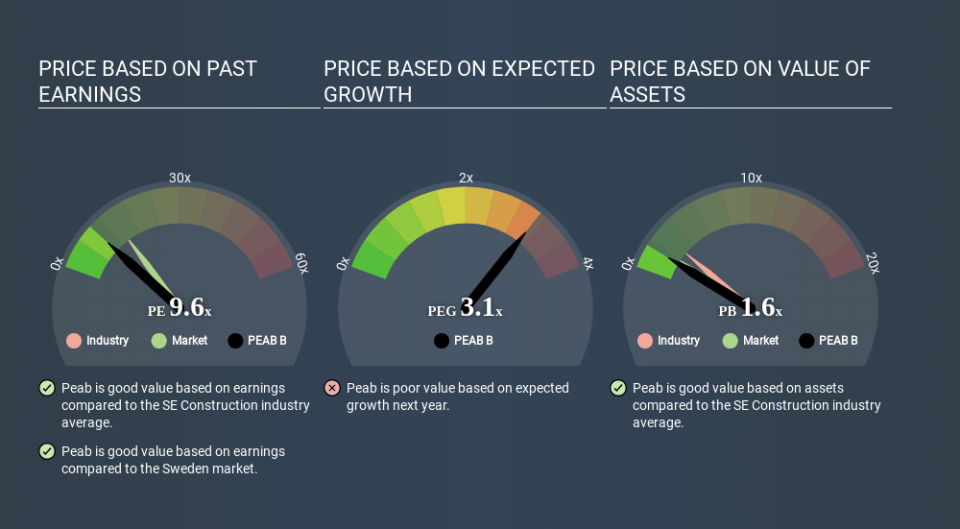What Is Peab's (STO:PEAB B) P/E Ratio After Its Share Price Tanked?

Unfortunately for some shareholders, the Peab (STO:PEAB B) share price has dived 32% in the last thirty days. The recent drop has obliterated the annual return, with the share price now down 15% over that longer period.
All else being equal, a share price drop should make a stock more attractive to potential investors. While the market sentiment towards a stock is very changeable, in the long run, the share price will tend to move in the same direction as earnings per share. The implication here is that long term investors have an opportunity when expectations of a company are too low. One way to gauge market expectations of a stock is to look at its Price to Earnings Ratio (PE Ratio). A high P/E ratio means that investors have a high expectation about future growth, while a low P/E ratio means they have low expectations about future growth.
View our latest analysis for Peab
How Does Peab's P/E Ratio Compare To Its Peers?
We can tell from its P/E ratio of 9.61 that sentiment around Peab isn't particularly high. The image below shows that Peab has a lower P/E than the average (13.7) P/E for companies in the construction industry.
Peab's P/E tells us that market participants think it will not fare as well as its peers in the same industry. Since the market seems unimpressed with Peab, it's quite possible it could surprise on the upside. If you consider the stock interesting, further research is recommended. For example, I often monitor director buying and selling.
How Growth Rates Impact P/E Ratios
Probably the most important factor in determining what P/E a company trades on is the earnings growth. If earnings are growing quickly, then the 'E' in the equation will increase faster than it would otherwise. That means even if the current P/E is high, it will reduce over time if the share price stays flat. A lower P/E should indicate the stock is cheap relative to others -- and that may attract buyers.
Peab's earnings per share were pretty steady over the last year. But over the longer term (5 years) earnings per share have increased by 15%.
A Limitation: P/E Ratios Ignore Debt and Cash In The Bank
Don't forget that the P/E ratio considers market capitalization. In other words, it does not consider any debt or cash that the company may have on the balance sheet. Hypothetically, a company could reduce its future P/E ratio by spending its cash (or taking on debt) to achieve higher earnings.
Spending on growth might be good or bad a few years later, but the point is that the P/E ratio does not account for the option (or lack thereof).
So What Does Peab's Balance Sheet Tell Us?
Peab's net debt equates to 37% of its market capitalization. While it's worth keeping this in mind, it isn't a worry.
The Verdict On Peab's P/E Ratio
Peab trades on a P/E ratio of 9.6, which is below the SE market average of 14.1. The debt levels are not a major concern, but the lack of EPS growth is likely weighing on sentiment. Given Peab's P/E ratio has declined from 14.1 to 9.6 in the last month, we know for sure that the market is more worried about the business today, than it was back then. For those who prefer invest in growth, this stock apparently offers limited promise, but the deep value investors may find the pessimism around this stock enticing.
Investors have an opportunity when market expectations about a stock are wrong. As value investor Benjamin Graham famously said, 'In the short run, the market is a voting machine but in the long run, it is a weighing machine. So this free visual report on analyst forecasts could hold the key to an excellent investment decision.
Of course you might be able to find a better stock than Peab. So you may wish to see this free collection of other companies that have grown earnings strongly.
If you spot an error that warrants correction, please contact the editor at editorial-team@simplywallst.com. This article by Simply Wall St is general in nature. It does not constitute a recommendation to buy or sell any stock, and does not take account of your objectives, or your financial situation. Simply Wall St has no position in the stocks mentioned.
We aim to bring you long-term focused research analysis driven by fundamental data. Note that our analysis may not factor in the latest price-sensitive company announcements or qualitative material. Thank you for reading.

